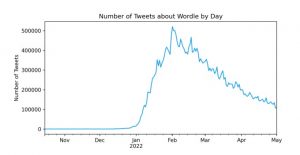
Wordle’s first-quarter financial results prove what we already knew: people love it.
I’m sure you know the story by now. For his partner, Josh Wardle made a simple word game, shared it with friends (who were some influential tech people, since Wardle worked at places like Reddit and MSCHF), who shared it with some more friends, and eventually everyone with an internet connection talked about it.
He didn’t try to make money from his ad-free, lightweight word game at first. At the end of January, he sold the game to The New York Times for an undisclosed amount in the “low seven figures.”
Wordle’s origins can be traced back to NYT games, so this step feels really natural to me,” Wardle said in a tweet. “When it moves to the NYT site, it’ll be free to play. I’m working with them to keep your streaks and wins.”
After Wordle sold to The New York Times, the paper announced that the game brought “unprecedented tens of millions of new users.” This drove the company’s most successful quarter for net subscriber additions. The New York Times has been advertising its other games like Spelling Bee through Wordle, even though Wordle is free. You can subscribe to New York Times Games for $5 a month, or $40 a year.
Wardle told New York Times Games weeks before the acquisition that the game was inspired by them. Since you can only play the game once a day, it’s not addictive like previous viral games. Game design like that is intentional.
We play a lot of The New York Times word games, and they follow the one-a-day model.”
Wordle creates a sense of community among players because everyone is solving the same puzzle. According to Wardle, “One thing that is interesting to reflect on is that Wordle could be updated every day, but if everyone got different words each day – if they were random, but you could only play one – it wouldn’t have caught on.”
The ease with which you can share your Wordle results in an emoji grid may have contributed to Wordle’s virality.
Wordle results are shared on WhatsApp, Facebook, and texts to moms, but Twitter is also a big factor.
Data scientist Lauren Fratamico published a case study yesterday about how Wordle spreads.

There have been 32.2 million tweets about Wordle since mid-October, according to the study. Over 6.6 trillion tweets about Wordle have been viewed, 58 million liked and 9 million replied to.
There were 500,000 tweets about Wordle a day at its peak – but that peak coincided with The New York Times buying the game, so it certainly contributed to the conversation. Tweets about Wordle are slowing down (now it’s about 200,000 per day), but that doesn’t mean people aren’t playing. Sharing your scores every day has gotten a little cheesy.
“One thing I’ll say is that most players don’t post their results on Twitter,” Wardle told me in January. A Wordle Stats account looks at Twitter, collects grids people share, then posts them the next day and says, ‘Okay, 30% of people got it in four,’ and it got 100,000-something two days ago, when there were 2 million players on Wordle at the time.”
According to the sample size of people who tweeted Wordle results, the hardest word was SWILL (2/19/22), which took tweeters an average of 4.88 guesses. PLANT (4/22/22) was the easiest, taking an average of 3.32 guesses to solve.



